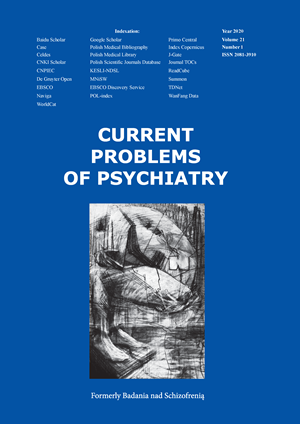The role of social media in the process of shaping the "body cult" amongyoung women
DOI:
https://doi.org/10.2478/cpp-2020-0002Keywords:
"body cult", social media, eating disordersAbstract
Introduction. The purpose of this article is to analyse the phenomenon of "body cult" as well as psychological and social factors conditioning its occurrence among young women. Particular attention was paid to the role of social media and an attempt was made to indicate possible preventive measures to promote health-popularising behaviour towards the body among high school students.
Materials and methods. On the basis of the review of the available literature, developmental conditions of the adolescence period and research results on the subject were presented.
Results. The paper presents the role of social media in the context of shaping behaviours related to "body cult".
Conclusions. The content presented on blogs and social networks put pressure on young women to cultivate the physical characteristics of a person. In this perspective, excessive focus on striving for the perfect figure can lead to the development of anti-health behaviour. Further research is definitely needed.
References
1. Hill AJ. Motivation for eating behaviour in adolescent girls: the body beautiful. Proceedings of the Nutrition Society, 2006; 65: 376-384.
2. Buchowska D. Wykorzystanie mediów społecznościowych przez uczelnie wyższe i studentów w świetle badań własnych. Nauki o zarządzaniu, 2013; 2: 36-50.
3. Andrzejewski A. Kompulsywne nadużywanie mediów społecznościowych a ryzyko rozwoju zaburzeń odżywiania – na przykładzie aplikacji Instagram. Annales Universitatis Mariae Curie-Skłodowska, sectio J, Paedagogia-Psychologia, 2018; 31: 243-254.
4. Alsulami M, Sykes A, Amizian M. The role of social media in promoting sports fanaticism. International Journal of Psychological Rehabilitation, 2020; 24: 626-639.
5. Watanabe-Ito M, Kishi E, Shimizu Y. Promoting Healthy Eating Habits for College Students Through Creating Dietary Diaries via a Smartphone App and Social Media Interaction: Online Survey Study, 2020; 3: 17613.
6. Brzezińska A. Dorosłość – szanse i zagrożenia dla rozwoju. W: Brzezińska A, Appelt K, Wojciechowska J. red. Szanse i zagrożenia rozwoju w okresie dorosłości. Poznań; Wydawnictwo Fundacji Humaniora: 2002. s. 11-22.
7. Ziółkowska B. Okres dorastania. Jak rozpoznać ryzyko i jak pomagać? W: Brzezińska AI. red. Psychologiczne portrety człowieka. Praktyczna psychologia rozwojowa. Gdańsk; Gdańskie Wydawnictwo Psychologiczne: 2005. s. 379-423.
8. Stiels-Shields C, Bamford B, Lock, J, Le Grange, D. The Effect of Driven Exercise on Treatment Outcomes for Adolescents with Anorexia and Bulimia Nervosa. International Journal of Eating Disorders. 2015; 48: 392-396.
9. Bergstrom R, Neighbors, C, Malheim, J. Media comparisons and threats to body image: seeking evidence of self-affirmation. Journal of Social and Clinical Psychology. 2009; 28: 264-280.
10. Melki J, Hitti E, Oghia M, Mufarrij A. Media exposure, mediated social comparison to idealized images of muscularity, and anabolic steroid use. Health Communication, 2015; 30: 473-484.
11. Gajtkowska M. Obraz własnego ciała współczesnej młodzieży a kultura popularna. Badania własne. Kultura-Społeczeństwo-Edukacja, 2013; 103-118.
12. Maltby J, Giles DC, Barber L, McCutcheon LE. Intense‐personal celebrity worship and body image: Evidence of a link among female adolescents. British journal of health psychology. 2005; 10: 17-32.
13. Singh Mannat M, Parsekar, SS, Bhumika, TV. Body Image, Eating Disorders and Role of Media among Indian Adolescents. Journal of Indian Association for Child & Adolescent Mental Health, 2016; 12: 198-203.
14. Głębocka A, Kulbat, J. Czym jest wizerunek ciała? W: Głębocka A. Kulbat J. red. Wizerunek Ciała: Portret Polek. Opole; Wydawnictwo UO: 2005. s. 9-28.
15. Smolak L, Levine, MP. Body image in children. W: J.K. Thompson J.K. Smolak L. red. Body image, Eating Disorders, and Obesity in Youth, Assessment, Prevention, and Treatment. Washington; American Psychological Assocation: 2001. s. 41-66.
16. Izydorczyk B. Postawy i zachowania wobec własnego ciała w zaburzeniach odżywiania. Warszawa; Wydawnictwo Naukowe PWN: 2015.
17. Harrison K. Ourselves, our bodies: Thin-ideal media, selfdiscrepancies, and eating disorder symptomatology in adolescents. Journal of Social and Clinical Psychology/ 2001; 20: 289-323.
18. Singh Mannat M, Parsekar SS, Bhumika TV. Body Image, Eating Disorders and Role of Media among Indian Adolescents. Journal of Indian Association for Child & Adolescent Mental Health. 2016; 12: 9-35.
19. Pużyński S, Wciórka J. Klasyfikacja zaburzeń psychicznych i zaburzeń zachowania w ICD-10. Kraków-Warszawa; Uniwersyteckie Wydawnictwo Medyczne Vesalius: 2000.
20. Gałecki P, Pilecki M, Rymaszewska J, Szulc A, Sidorowicz S, Wciórka, J. Kryteria diagnostyczne zaburzeń psychicznych DSM-5®. Wrocław; Edra Urban & Partner: 2018.
21. Jacennik B. Strategie dla zdrowia: kształtowanie zachowań zdrowotnych poprzez środowisko. Warszawa; Vizje Press IT: 2008.
22. Heszen I, Sęk H. Psychologia zdrowia. Warszawa; Wydawnictwo Naukowe PWN: 2007.
23. Goleman, D. Inteligencja emocjonalna, Poznań; Media Rodzina: 1997.
24. Gaś ZB. Psychoprofilaktyka. Procedury konstruowania programów wczesnej interwencji. Lublin; Wydawnictwo UMCS: 1998.
Downloads
Published
Issue
Section
License
Copyright (c) 2020 Authors

This work is licensed under a Creative Commons Attribution 4.0 International License.


